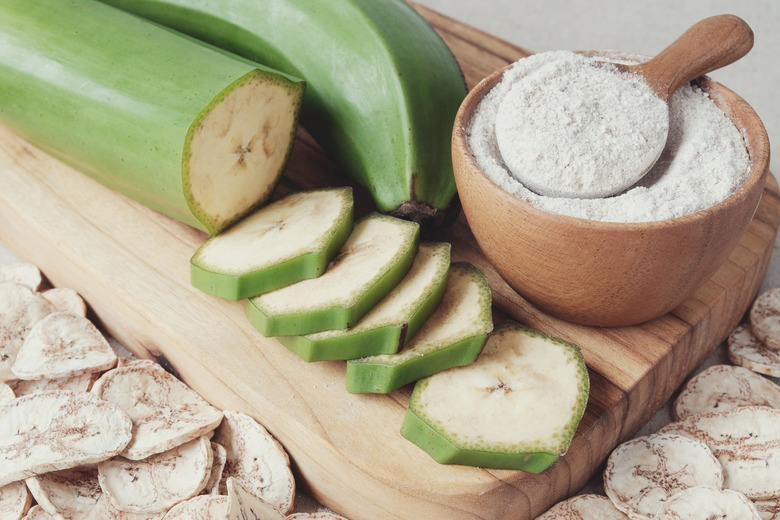Banana Flour Is The Gluten-Free Baking Alternative You Didn't Know You Needed
The whole "gluten-free" thing is hard enough, but for the most part you've managed to adapt. You're a wizard at restaurant ordering, you know which liquors won't upset your stomach, and you've learned to make some delicious gluten-free dinners. But gluten-free baking is rough — literally. Many gluten-free swaps for desserts can end up tasting mealy, dense, and all-around unsatisfying to your sweets cravings.
Banana flour, the newest flour alternative to gain popularity this year, might just be the light, fluffy solution to your baking woes. It's made from just one ingredient: ground, dried bananas. That means that it's not only gluten-free but also paleo, Whole30-approved, and vegan. The only diet it might not work for is the keto diet, since the diet mandates you limit your fruit intake.
In addition to being safely gluten-free, the flour may have health benefits. It's similar in calories to regular white flour, but made of a different type of carbohydrate. White flour is made from simple starches that are quickly absorbed and turned into energy. Banana flour, on the other hand, "is made from green bananas, a good source of resistant starch," registered dietitian Amy Margulies told The Daily Meal in an email.
Resistant starches are resistant to absorption and digestion, functioning somewhat similarly to soluble fibers. These compounds slow down the digestion of carbohydrates and are not fully absorbed by the body. Resistant starches are also found in foods such as whole grains, vegetables, and legumes.
"Resistant starch has been found to be beneficial for colon health, increasing satiety levels, and lowering blood sugar," said Margulies. "Banana flour is an excellent source of phenolic acid, a type of phytochemical found in many plant foods. It works like an antioxidant and supplies both potassium and vitamin B6."
Using the flour is simple. Rather than including wheat-based flour in a recipe, simply replace this ingredient with slightly less banana flour.
According to a representative from Pereg Foods, one of the companies to sell banana flour, "the rule of thumb is to use 30 percent less banana flour than wheat flour." This is due to its high starch content — a little goes a long way.
Using banana flour in a recipe "yields a slight banana flavor to the end results," the company claims, but not much else in terms of flavor. So your cookies or cakes or whatever else you're baking shouldn't taste too strongly of banana.
According to Margulies, banana flour bakes wonderfully into light and fluffy desserts and breads — no dense, mealy texture. Hopefully, this flour can help gluten-free eaters to taste less disappointment in their dessert. Products like these can help keep desserts delicious and healthy. Now if only there were a way to indulge without all that sugar...
